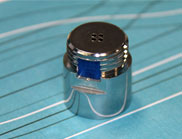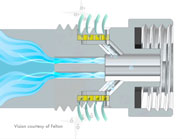‘Air shower’ saves 50 per cent water
Dr Jie Wu, a fluids specialist at CSIRO, says the Oxijet nozzle developed by New Zealand company Felton in collaboration with CSIRO, feels just as wet and strong as a full flow shower, but uses much less water. The device, based on a CSIRO laboratory concept of using a novel aeration insert, also differs from traditional ‘low flow’ devices.
“This expands the volume of the shower stream, meaning you can save the same amount of water, while still enjoying your shower.”
Dr Jie Wu, CSIRO Fluids Engineering
“Traditional flow restrictors reduce flow and pressure, whereas Oxijet uses the flow energy to draw air into the water stream, making the water droplets hollow,” Dr Wu said.
“This expands the volume of the shower stream, meaning you can save the same amount of water, while still enjoying your shower.”
With all Australian states currently under water restrictions or permanent water efficiency measures, household water use is decreasing but prices are going up, according to the Australian Bureau of Statistics. Oxijet could provide a cost effective way to reduce household water consumption, without effecting comfort.
The device was recently trialled by Novotel Northbeach in Wollongong and is planned to be installed across the whole hotel.
“With over 200 rooms we go through over 10 million litres of water per year, so any saving we can make is very important. We’ve found our customers prefer Oxijet over other ‘low flow’ shower heads, because it gives the illusion of full water pressure,” Mr Walter Immoos, General Manager of Novotel Northbeach said.
Roger Marty, General Manager of Felton, said CSIRO’s expertise was invaluable when developing Oxijet.
“The concept of using an aerated showerhead to save water is not new, but the technology behind our device using an aerator insert allows the device to work with existing showers already installed. Our engineers worked with Dr Wu’s team to turn the concept into an inexpensive, quality product,” he said.
Oxijet can be fitted to most existing shower heads and is accredited by the Australian Watermark and Water Efficiency and Labelling Standards. It is now available for purchase in Australia.
Media resources
Click image for high resolution version


